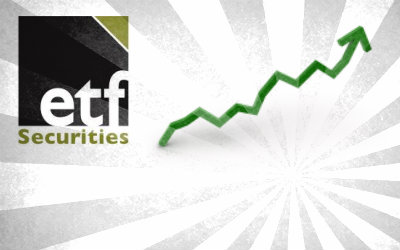Analys
Cyklisk rotation driver rekordstora inflöden till olje-ETPer och utflöden från guld

 Råvaror fortsatte att prestera dåligt under Q4 2014 och året som helhet är det sämsta för tillgångsklassen sedan finanskrisen. En perfekt storm av faktorer – starkt utbud inom de flesta råvarusektorerna, oro över efterfrågan från Kina och en starkare amerikansk dollar – ligger bakom de låga råvarupriserna och att det globala förvaltade kapitalet sjönk till 101,5 miljarder dollar i Q4, en minskning med 9,2 miljarder dollar jämfört med Q3. Nettoflödena till råvaru-ETPer var neutrala och minskningen av förvaltat kapital bestod i sin helhet av prisändringar. Investerarna tycks se det nuvarande läget som ett tillfälle att öka sin exponering mot cykliska råvarutillgångar och rotera bort från mer defensiva exponeringar som guld.
Råvaror fortsatte att prestera dåligt under Q4 2014 och året som helhet är det sämsta för tillgångsklassen sedan finanskrisen. En perfekt storm av faktorer – starkt utbud inom de flesta råvarusektorerna, oro över efterfrågan från Kina och en starkare amerikansk dollar – ligger bakom de låga råvarupriserna och att det globala förvaltade kapitalet sjönk till 101,5 miljarder dollar i Q4, en minskning med 9,2 miljarder dollar jämfört med Q3. Nettoflödena till råvaru-ETPer var neutrala och minskningen av förvaltat kapital bestod i sin helhet av prisändringar. Investerarna tycks se det nuvarande läget som ett tillfälle att öka sin exponering mot cykliska råvarutillgångar och rotera bort från mer defensiva exponeringar som guld.
Det rekordstora inflödet till energisektorn vägde i stort sett upp det stora utflödet från guld-ETPer i Q4 2014 och resultatet blev ett nettoutflöde för råvaru-ETPer på måttliga 30 miljoner dollar. Guld-ETPer hade det största kvartalsutflödet på ett år, totalt 3,1 miljarder dollar, och flödena kom framförallt från amerikanska investerare (78 %) som fått ökat förtroende för USAs återhämtning. Amerikanska investerare drev även det starka inflödet till energi-ETPer och stod för 85 % av det totala inflödet på 3,2 miljarder dollar.
”Investerarna återvänder till råvaror, attraherade av priser som ligger på eller under produktionskostnaden. I det korta perspektivet kan företag och gruvor fortsätta producera trots att priserna ligger under produktionskostnaden, men det är inte hållbart i längden. Om vi inte börjar se en prisuppgång snart kommer produktionen förr eller senare sjunka. Minskat utbud kommer resultera i högre råvarupriser under 2015”, säger Peter Lidblom, Nordenchef på ETF Securities.
Den starka amerikanska dollarn har också bidragit till att dämpa råvarupriserna. Dollarns framfart är dock pådriven av en stark amerikansk ekonomisk tillväxt vilket i grunden är positivt för efterfrågan på råvaror. Samtidigt förväntas beslutsfattare i både Kina och Europa fortsätta reagera starkt på den senaste tidens svaga ekonomiska utveckling i de båda regionerna.
Cykliska råvaror förväntas bli de stora vinnarna av den ekonomiska återhämtningen i USA och Kina under 2015. Kina fortsätter stimulera sin ekonomi och planerar fler råvaruintensiva infrastrukturinvesteringar under 2015 vilket kommer ha en positiv inverkan på de råvaror som är beroende av ekonomisk aktivitet. De bästa investeringsmöjligheterna inför 2015 finns inom cykliska tillgångar givet den tilltagande globala återhämtningen. Men det finns risker, inte minst gällande svagare tillväxt och hot om deflation i Euroområdet och Japan, samt den trögare ekonomiska återhämtningen i Storbritannien. Våra främsta tips inför 2015 är råvarusektorer med exponering mot industrin, som till exempel metaller och energi.
Sammanfattning av de främsta trenderna under 2014:
Förvaltat kapital i råvaru-ETPer sjönk med 20,6 miljarder dollar till 101,5 miljarder dollar i slutet av 2014. En stark amerikansk dollar och oro över tillväxten i Kina och Europa pressade ner många råvarupriser under produktionskostnad.
Taktiska investerare har varit aktiva i råvaror under hela 2014 och investerarnas uthållighet reflekterar den strategiska karaktären hos innehavare av råvaru-ETPer.
Nästan 100 % av nedgången i förvaltat kapital för råvaror under 2014 berodde på prisfall. Nettoutflödet uppgick till måttliga 30 miljoner dollar vilket visar att investerarna verkar rotera in i mer cykliska råvaruexponeringar.
Många råvaror handlas nu på eller under produktionskostnaden. Detta lockar ett antal långsiktiga värdeinvesterare till enskilda råvaror och sektorer där prisnedgången varit särskilt aggressiv.
Ädelmetall-ETPer stod för över 70 % av nedgången i förvaltat kapital för råvaror under 2014. Det förvaltade kapitalet i ädelmetall-ETPer uppgick i slutet av året till 79 miljarder dollar, efter en minskning på 14,8 miljarder dollar under 2014. Utflödena från guld kom huvudsakligen från amerikanska investerare, troligen som ett resultat av mindre defensiva portföljpositioneringar.
Palladium var den enda ädelmetallen som gick mot trenden med ökat förvaltat kapital på 0,9 miljarder dollar. Bakom ökningen låg hotet om utbudsstörningar och en positiv efterfråga vilket höll priserna uppe under 2014. Ökningen i förvaltat kapital bestod till hälften av inflöden.
Guld undantaget hade alla ädelmetaller nettoinflöden under året. Platina och palladium gynnades av potentiella utbudsstörningar i Sydafrika och Ryssland och hade de största inflödena på 432 respektive 376 miljoner dollar.
Energi-ETPer hade starka inflöden under 2014, framförallt under de sista tre månaderna då prisfallet för råolja och naturgas upplevdes överdrivet. Råolja hade den största andelen inflöden medan naturgas stod för runt 25 %. De globala inflödena var mestadels drivna av amerikanska investerare som stod för runt 85 %. Hela inflödet till naturgas kom från amerikanska investerare då stora lager och milt väder tvingade ner priserna på den lägsta nivån sedan 2012.
Näst efter energisektorn hade breda råvaruindex-ETPer de största inflödena (1,1 miljarder dollar) under 2014. Detta indikerar att investerarna börjar se råvaror som en tillgångsklass med högt relativt värde när värderingarna på aktie- och räntemarknaderna skjutit i höjden samtidigt som råvarupriserna gått ner.
Investerarna eftersökte större exponering mot korn, vilket delvis kompenserade utflöden från breda jordbruks-ETPer under 2014. Låga priser på majs och vete attraherade långsiktiga investerare som tror att odlingsförhållandena sannolikt inte kommer vara lika goda den här säsongen som förra. Kaffe hade det största utflödet eftersom möjligheten att El-Nino inträffar under 2015 skulle kunna öka utbudet.
Industrimetaller hade blandade flöden och slutade året med ett utflöde på måttliga 2 miljoner dollar. Problem på utbudssidan gjorde att nickel hade inflöden under varje kvartal under 2014, totalt 122 miljoner dollar. Oro över Kinesisk efterfrågan och ökad finansieringsrisk fick investerarna att dra sig ur koppar-ETPer (52 miljoner dollar). Diversifierade industrimetaller och zink-ETPer hade också utflöden.
Analys
Sell the rally. Trump has become predictable in his unpredictability

Hesitant today. Brent jumped to an intraday high of $66.36/b yesterday after having touched an intraday low of $60.07/b on Monday as Indian and Chinese buyers cancelled some Russian oil purchases and instead redirected their purchases towards the Middle East due to the news US sanctions. Brent is falling back 0.4% this morning to $65.8/b.

It’s our strong view that the only sensible thing is to sell this rally. In all Trump’s unpredictability he has become increasingly predictable. Again and again he has rumbled about how he is going to be tough on Putin. Punish Putin if he won’t agree to peace in Ukraine. Recent rumbling was about the Tomahawk rockets which Trump threatened on 10 October and 12 October to sell/send to Ukraine. Then on 17 October he said that ”the U.S. didn’t want to give away weapons (Tomahawks) it needs”.
All of Trump’s threats towards Putin have been hot air. So far Trump’s threats have been all hot air and threats which later have evaporated after ”great talks with Putin”. After all these repetitions it is very hard to believe that this time will be any different. The new sanctions won’t take effect before 21. November. Trump has already said that: ”he was hoping that these new sanctions would be very short-lived in any case”. Come 21. November these new sanctions will either evaporate like all the other threats Trump has thrown at Putin before fading them. Or the sanctions will be postponed by another 4 weeks or 8 weeks with the appearance that Trump is even more angry with Putin. But so far Trump has done nothing that hurt Putin/Russia. We can’t imagine that this will be different. The only way forward in our view for a propre lasting peace in Ukraine is to turn Ukraine into defensive porcupine equipped with a stinging tail if need be.
China will likely stand up to Trump if new sanctions really materialize on 21 Nov. Just one country has really stood up to Trump in his tariff trade war this year: China. China has come of age and strength. I will no longer be bullied. Trump upped tariffs. China responded in kind. Trump cut China off from high-end computer chips. China put on the breaks on rare earth metals. China won’t be bullied any more and it has the power to stand up. Some Chinese state-owned companies like Sinopec have cancelled some of their Russian purchases. But China’s Foreign Ministry spokesperson Guo Jiakun has stated that China “oppose unilateral sanctions which lack a basis in international law and authorization of the UN Security Council”. Thus no one, not even the US shall unilaterally dictate China from whom they can buy oil or not. This is yet another opportunity for China to show its new strength and stand up to Trump in a show of force. Exactly how China choses to play this remains to be seen. But China won’t be bullied by over something as important as its oil purchases. So best guess here is that China will defy Trump on this. But probably China won’t need to make a bid deal over this. Firstly because these new sanctions will either evaporate as all the other threats or be postponed once we get to 21 November. Secondly because the sanctions are explicit towards US persons and companies but only ”may” be enforced versus non-US entities.
Sanctions is not a reduction in global supply of oil. Just some added layer of friction. Anyhow, the new sanctions won’t reduce the supply of Russian crude oil to the market. It will only increase the friction in the market with yet more need for the shadow fleet and ship to ship transfer of Russian oil to dodge the sanctions. If they materialize at all.
The jump in crude oil prices is probably due to redirections of crude purchases to the Mid-East and not because all speculators are now turned bullish. Has oil rallied because all speculators now suddenly have turned bullish? We don’t think so. Brent crude has probably jumped because some Indian and Chinese oil purchasers of have redirected their purchases from Russia towards the Mid-East just in case the sanctions really materializes on 21 November.
Analys
Brent crude set to dip its feet into the high $50ies/b this week

Parts of the Brent crude curve dipping into the high $50ies/b. Brent crude fell 2.3% over the week to Friday. It closed the week at $61.29/b, a slight gain on the day, but also traded to a low of $60.14/b that same day and just barely avoided trading into the $50ies/b. This morning it is risk-on in equities which seems to help industrial metals a little higher. But no such luck for oil. It is down 0.8% at $60.8/b. This week looks set for Brent crude to dip its feet in the $50ies/b. The Brent 3mth contract actually traded into the high $50ies/b on Friday.

The front-end backwardation has been on a weakening foot and is now about to fully disappear. The lowest point of the crude oil curve has also moved steadily lower and lower and its discount to the 5yr contract is now $6.8/b. A solid contango. The Brent 3mth contract did actually dip into the $50ies/b intraday on Friday when it traded to a low point of $59.93/b.
More weakness to come as lots of oil at sea comes to ports. Mid-East OPEC countries have boosted exports along with lower post summer consumption and higher production. The result is highly visibly in oil at sea which increased by 17 mb to 1,311 mb over the week to Sunday. Up 185 mb since mid-August. On its way to discharge at a port somewhere over the coming month or two.
Don’t forget that the oil market path ahead is all down to OPEC+. Remember that what is playing out in the oil market now is all by design by OPEC+. The group has decided that the unwind of the voluntary cuts is what it wants to do. In a combination of meeting demand from consumers as well as taking back market share. But we need to remember that how this plays out going forward is all at the mercy of what OPEC+ decides to do. It will halt the unwinding at some point. It will revert to cuts instead of unwind at some point.
A few months with Brent at $55/b and 40-50 US shale oil rigs kicked out may be what is needed. We think OPEC+ needs to see the exit of another 40-50 drilling rigs in the US shale oil patches to set US shale oil production on a path to of a 1 mb/d year on year decline Dec-25 to Dec-26. We are not there yet. But a 2-3 months period with Brent crude averaging $55/b would probably do it.
Oil on water increased 17 mb over the week to Sunday while oil in transit increased by 23 mb. So less oil was standing still. More was moving.

Crude oil floating storage (stationary more than 7 days). Down 11 mb over week to Sunday

The lowest point of the Brent crude oil curve versus the 5yr contract. Weakest so far this year.

Crude oil 1mth to 3mth time-spreads. Dubai held out strongly through summer, but then that center of strength fell apart in late September and has been leading weakness in crude curves lower since then.

Analys
Crude oil soon coming to a port near you

Rebounding along with most markets. But concerns over solidity of Gaza peace may also contribute. Brent crude fell 0.8% yesterday to $61.91/b and its lowest close since May this year. This morning it is bouncing up 0.9% to $62.5/b along with a softer USD amid positive sentiment with both equities and industrial metals moving higher. Concerns that the peace in Gaza may be less solid than what one might hope for also yields some support to Brent. Bets on tech stocks are rebounding, defying fears of trade war. Money moving back into markets. Gold continues upwards its strong trend and a softer dollar helps it higher today as well.

US crude & products probably rose 5.6 mb last week (API) versus a normal seasonal decline of 2.4 mb. The US API last night partial and thus indicative data for US oil inventories. Their data indicates that US crude stocks rose 7.4 mb last week, gasoline stocks rose 3.0 mb while Distillate stocks fell 4.8 mb. Altogether an increase in commercial crude and product stocks of 5.6 mb. Commercial US crude and product stocks normally decline by 2.4 mb this time of year. So seasonally adjusted the US inventories rose 8 mb last week according to the indicative numbers by the API. That is a lot. Also, the counter seasonal trend of rising stocks versus normally declining stocks this time of year looks on a solid pace of continuation. If the API is correct then total US crude and product stocks would stand 41 mb higher than one year ago and 6 mb higher than the 2015-19 average. And if we combine this with our knowledge of a sharp increase in production and exports by OPEC(+) and a large increase in oil at sea, then the current trend in US oil inventories looks set to continue. So higher stocks and lower crude oil prices until OPEC(+) switch to cuts. Actual US oil inventory data today at 18:00 CET.
US commercial crude and product stocks rising to 1293 mb in week 41 if last nights indicative numbers from API are correct.

Crude oil soon coming to a port near you. OPEC has lifted production sharply higher this autumn. At the same time demand for oil in the Middle-East has fallen as we have moved out of summer heat and crude oil burn for power for air-conditioning. The Middle-East oil producers have thus been able to lift exports higher on both accounts. Crude oil and condensates on water has shot up by 177 mb since mid-August. This oil is now on its way to ports around the world. And when they arrive, it will likely help to lift stocks onshore higher. That is probably when we will lose the last bit of front-end backwardation the the crude oil curves. That will help to drive the front-month Brent crude oil price down to the $60/b line and revisit the high $50ies/b. Then the eyes will be all back on OPEC+ when they meet in early November and then again in early December.
Crude oil and condensates at sea have moved straight up by 177 mb since mid-August as OPEC(+) has produced more, consumed less and exported more.

-

 Nyheter4 veckor sedan
Nyheter4 veckor sedanOPEC+ missar produktionsmål, stöder oljepriserna
-

 Nyheter3 veckor sedan
Nyheter3 veckor sedanGoldman Sachs höjer prognosen för guld, tror priset når 4900 USD
-

 Nyheter4 veckor sedan
Nyheter4 veckor sedanBlykalla och amerikanska Oklo inleder ett samarbete
-

 Nyheter3 veckor sedan
Nyheter3 veckor sedanGuld nära 4000 USD och silver 50 USD, därför kan de fortsätta stiga
-

 Nyheter2 veckor sedan
Nyheter2 veckor sedanLeading Edge Materials är på rätt plats i rätt tid
-

 Nyheter3 veckor sedan
Nyheter3 veckor sedanNytt prisrekord, guld stiger över 4000 USD
-

 Nyheter4 veckor sedan
Nyheter4 veckor sedanEtt samtal om guld, olja, koppar och stål
-

 Analys4 veckor sedan
Analys4 veckor sedanOPEC+ will likely unwind 500 kb/d of voluntary quotas in October. But a full unwind of 1.5 mb/d in one go could be in the cards









